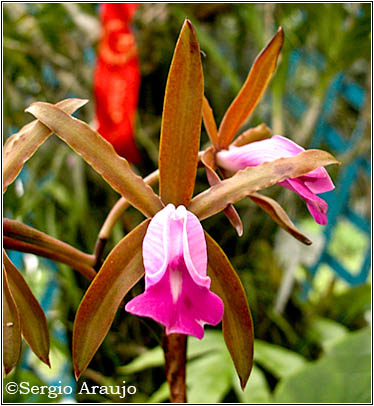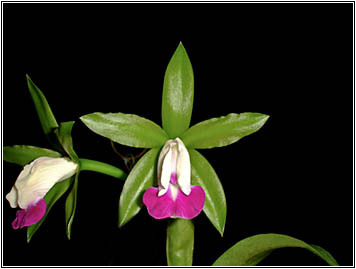
Paulo
Roberto Pancotto is an orchidist, graduated in Administration with
post-graduation in stock-market. He got involved with orchids since
22 years ago.
Report
by
Paulo Roberto Pancotto
"It
was a beautiful journey to see Cattleya dormaniana blooming.
The walk lasted for ten hours, going up and down, in an area very
difficult to be reached and I believe that is the reason for being
still safe. We found a habitat with a good population formed
by matured plants and I can say that there were at about 150 plants
and a great quantity of small-sized seedlings which means that this
small treasure is in perfect balance because its pollinator is active
and doing a good job.
Those plants were very well adapted, healthy, with a luxuriant blooming,
little variation in the color but, on the other hand, they presented
in their floral stems two flowers with same size, which is for the
species a great event. They were found in a very humid environment
because they were place over a multitude of bromeliads. Those plants
are also responsible for a great accumulation of water which is
constantly in evaporation.
The luminosity was, in most plants, at about 50%, but, at the same
time, we found plants which were at noon completely exposed to the
sunbeam. However, due to the great refrigeration supplied by the
combination of water from the bromeliads with the heat and ventilation,
we haven't seen any plant burnt. This habitat is found at, approximately,
600m altitude." |
| Photos: Paulo
R. Pancotto |

 |
Cattleya dormaniana (Rchb f.) Rchb. f. 1882
This species has been described as Laelia dormaniana by Rchb.
f. in l880, probably due to the fact that it produces two or four
extra rudimentary pollinia and Laelia species produce 8
ones
In l882, he transferred to the genus Cattleya.
At the beginning, he thought it was a natural hybrid of Cattleya
bicolor and Laelia pumila. Latterly the doubt was removed
and Cogniaux (Flora Brasiliensis, Martius, 1898) and, more
recently, Dressler & Gillespies (Bulletin AOS - 1960) considered
it a valid species.
There are many propositions for the classification of the Brazilian
species of Cattleya and, concerning Cattleya
dormaniana, they are justified due to the shape of the flowers.
Para Cogniaux (Flora Brasiliensis, Martius, 1898), Cattleya dormaniana
it belongs to Cryptochila section, subsection Diphyllae,
Series Intermedia.
For Pabst e Dungs (Orchidaceae Brasiliensis - 1975) it would be
included inside C. guttata Alliance.
For Fowlie (The Brazilian Bifoliate Cattleyas and Their Color Varieties
- 1977) and Carl L. Withner (The Cattleyas and Their Relative -
vol. 1 - 1995) it would be included inside the Laelioidea
Section.
|
For Rolfe (Orchid Review - 1895) it would be par of the Cattleya
intermedia alliance.
For Brieger, Maatsch and Senghas (Schlechter' s Die Orchideen -
3rd edition - 1981) it would belong to the subgenus Diphyllae,
section Intermedia.
It is a endemic species for the state of Rio de Janeiro and Guido
Pabst, in the work "As Orquídeas do Estado da Guanabara",
published in the magazine Orquídea (September/October 1966)
informed that there is a material mentioned as collected by Blunt,
in Rio de Janeiro city, between 500 and 700m altitude. In the book
"Orchidaceae Brasiliensis" (Band I, 1975), he just mentioned
the occurrence for the state of Rio de Janeiro and did not include
the old state of Guanabara (Nowadays District of Rio de Janeiro
city).
According to Anton Ghillany, this species occurs in a peculiar situation,
in the Serra dos Órgãos (Órgãos Mountains)
where is found vegetating as saprophyte in dead trunks or in decomposition
above 600m (which coincides with Paulo Pancotto), in rainforest
extremely humid. However it also grows as epiphyte. Its habitat
varies between 600 and 1.000m altitude.
Plant
characteristics
The pseudobulbs size varies from 8 to 30cm and have two leaves with
good substance. According to David Miller et all (Serra dos Órgãos,
Sua História e Suas Orquídeas), this species grows
on a specific tree, probably Clusia organensis, in specific
and hard to be reached environments.
Floral
characteristics
The blooming
presents one flower, at the utmost two flowers per spike with good
substance and with, approximately, 9cm in width. They arise from
green sheath in a 9cm stem. The flowers almost unscented and can
reached 8cm diameter when opened. They last less than 15 days.
The type-flower has undulated petals and sepals and are olive-green
with brown-reddish margins. The lip is purple and the lateral lobes
are pink and cover the column. It presents a fin vertical white
blotch. The floral segments are backward projected.
The alba variety was described by L. C Menezes (Boletim CAOB, vol
III/2 jan/abril 91) based on two specimens with greenish petals
and sepals and entirely white lip. The semi-alba variety has green
petals and sepals and the central lobe of the lip is purple and
lateral ones are white.
Sergio A. A. de Oliveira, in the article published in CAOB bulletin
also mentioned a flamea variety.

C. dormaniana
semi-alba (photo: Fernando Terra Manzan)
Cultivation
It is one of the easiest and should be cultivated in a temperate
climate, with a cool winter and moderate luminosity. When cultivated
in hotter climate, it tends to be weakened and the flowers do not
present a good shape with less substance.
It needs to be well watered during the growth period and should
have a rest during the winter. As every bifoliate species of Cattleya,
due to the cane-like stems, it should not be stayed dry for long
time because the stems could be dehydrated and become wrinkled making
the recuperation difficult.
Fortnightly apply a nitrogen-fertilizer and do not fertilizer at
all during the winter.
Hybrids
There is no register of natural hybrid of the species and just 9
artificial hybrids have been registered.
Cattleya Doinii (x dowiana), Cap Ziglar, Lambeauii (x labiata), Arthuriana (x luteola), Memoria Peter Petty, Lc Porphyrites (x Laelia pumila), Lc Sanderae (x L. xanthina), Lc Claptonensis (x Lc schilleriana) e C. Joan (Lambeauii x C. Fabia)
Synonyms
Laelia dormaniana Rchb f.
Laeliocattleya dormaniana Rolfe
Bibliography:
Hoehne - Iconografia de Orchidaceas do Brasil - Secretaria de Agricultura do Estado de São Paulo
Cogniaux - Flora Brasiliensis, Martius, 1898
Fowlie - The Brazilian Bifoliate Cattleyas and Their Color Varieties
Carl L. Withner - The Cattleyas and Their Relatives - Vol I
Pabst - As Orquídeas do Estado da Guanabara (revista Orquídea vol 28)
Pabst & Dungs - Orchidaceae Brasiliensis - Band I
Jim & Barbara McQueen - Orchids of Brazil -
L. C. Menezes - Boletim CAOB Ano III -- vol III/2 Jan-abril/91 - Orquídeas Raras
Sergio A. A. de Oliveira - Boletim CAOB Ano III -- vol III/4 Set-Dezl/91 - Algumas das mais belas Cattleyas bifoliadas, sua história, vairedades e cultivo, parte 2
David Miller et all - Serra dos Órgãos - Sua História e Suas Orquídeas |
Any
kind of reproduction (print, digital or anyone) of any type of material
of this site: texts, layout, photos, images and others - is
strictly forbidden without previous written permission of the authors.
Any solicitation or information by the e-mail:bo@sergioaraujo.com |
|